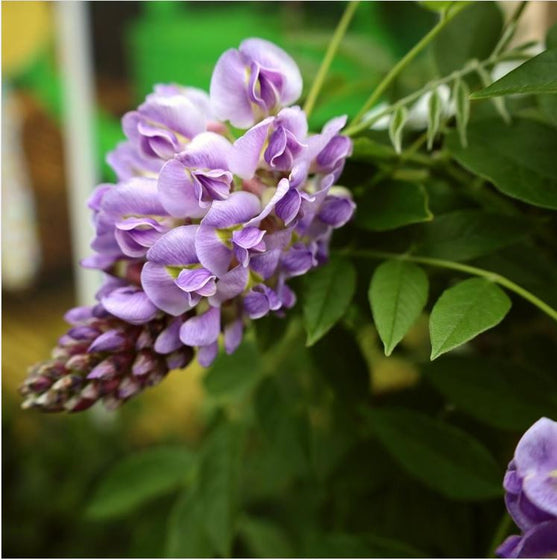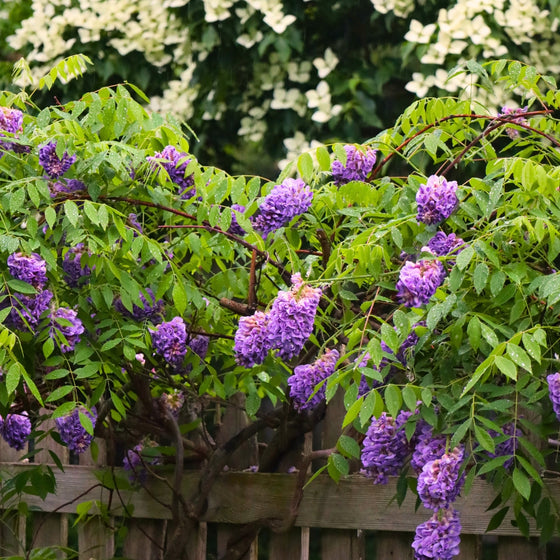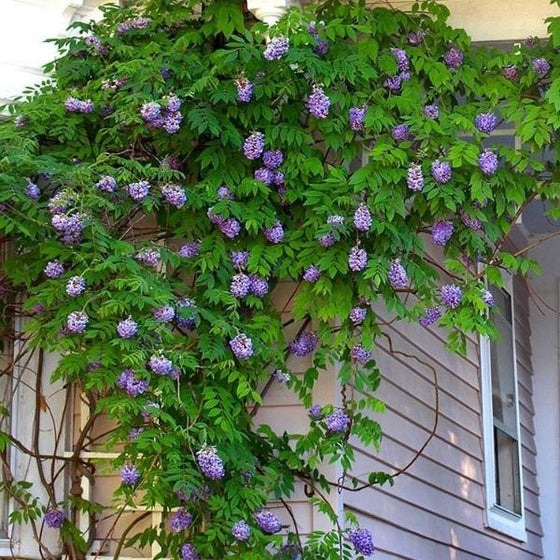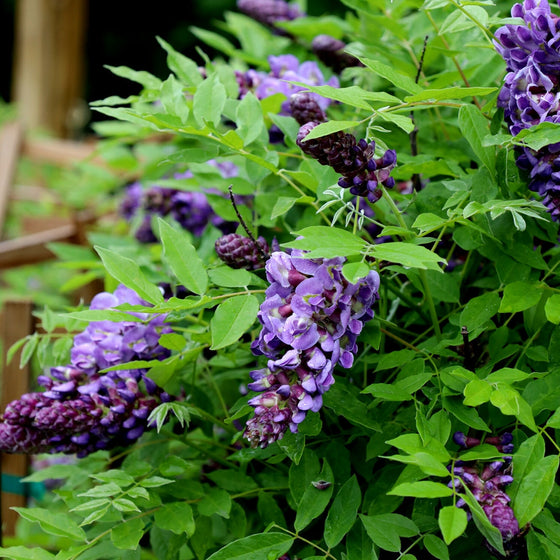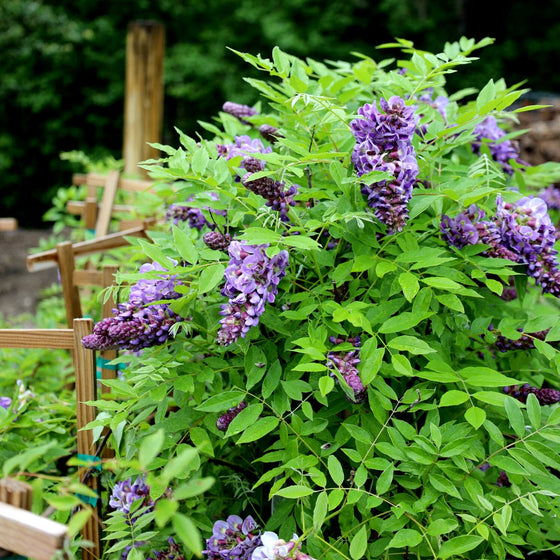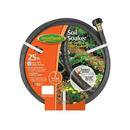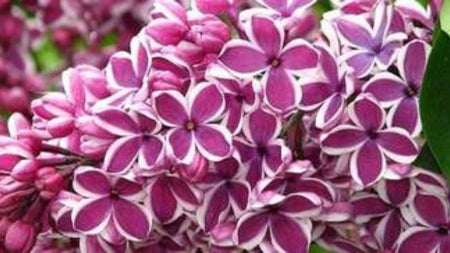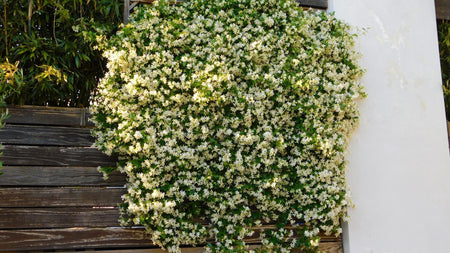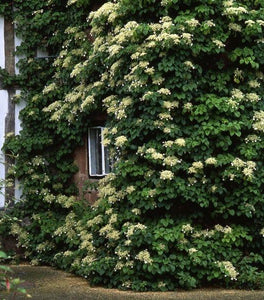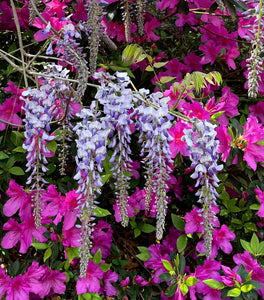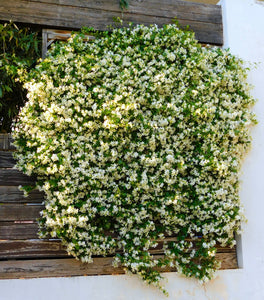
Images Depict Mature Plants
Wisteria Amethyst Falls Vine
Amethyst Falls Wisteria Vine (Wisteria frutescens 'Amethyst Falls') is a stunning, fast-growing native vine prized for its fragrant, cascading clusters of lavender-purple flowers. Blooming in late spring with repeat blooms through summer, this compact wisteria variety offers all the beauty of traditional Asian wisteria without the aggressive growth. Each raceme of delicate, amethyst-colored blooms hangs gracefully from the vine, adding elegance and vertical interest to arbors, trellises, pergolas, and fences. Its manageable size—typically reaching 10 to 15 feet long—makes it ideal for small gardens or tight spaces where traditional wisteria might overwhelm.
Unlike its more invasive cousins, Amethyst Falls Wisteria is a non-invasive, North American native that’s much easier to control and maintain. Hardy in USDA zones 5–9, it thrives in full sun and well-drained soil, rewarding gardeners with reliable blooms and lush, green foliage. This low-maintenance vine is drought-tolerant once established and resistant to most pests and diseases, making it an excellent choice for sustainable landscaping. It’s also deer resistant and attracts butterflies and pollinators, making it as ecologically beneficial as it is beautiful.
Whether used to create a romantic flowering canopy, a living privacy screen, or a striking vertical accent, Amethyst Falls Wisteria Vine offers long-lasting charm with far less maintenance than traditional varieties. It’s the perfect choice for adding color, fragrance, and pollinator appeal to any sunny garden space. With its elegant blooms, compact growth, and native roots, Amethyst Falls brings graceful beauty and garden-friendly performance to landscapes both large and small.
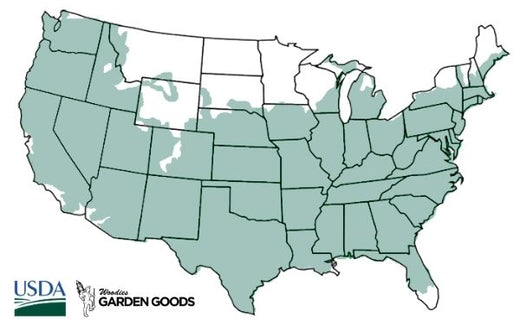
| Hardiness Zone: | 5-9 |
|---|---|
| Mature Height: | 10 to 12 Feet |
| Mature Width: | 3 to 4 Feet |
| Classification: | Broad leaved native deciduous vine |
| Sunlight: | Full sun to part sun |
| Habit: | Upright, climbing plant |
| Flower Color: | Soft purple flowers in late spring to early summer |
| Foliage: | Medium green turning yellow in the fall |
| Pruning Season: | Late winter to early spring, promotes increased branching and more flowers |
| Soil Condition: | Any well drained soil |
| Water Requirements: | Water well until established |
| Uses: | Extremely attractive when used as a vine on trellises. Provides nectar sources for pollinators. |
How to Care for Amethyst Falls Wisteria Vine
Before you buy an Amethyst Falls Wisteria Vine, make sure to read about the recommended care instructions to keep this plant healthy and thriving.
How do I plant an Amethyst Falls Wisteria Vine?
Planting an Amethyst Falls Wisteria vine successfully starts with choosing the right location. This American wisteria variety thrives in full sun, needing at least 6 hours of direct sunlight per day to produce its signature cascading purple-blue blooms. Select a spot with well-draining soil and sturdy support, such as a trellis, arbor, or pergola, as this vine is a vigorous climber. Dig a hole twice as wide and just as deep as the root ball, loosening the soil to encourage root expansion. Gently remove the plant from its container, place it in the hole at the same depth it was growing, and backfill with a mix of native soil and compost. Water deeply after planting to help the roots settle and eliminate air pockets. To promote healthy growth and long-term flowering, it’s important to space Amethyst Falls Wisteria vines properly—typically about 10 to 15 feet apart if planting multiple vines along a fence or structure. Mulch around the base with 2–3 inches of organic mulch to retain moisture and suppress weeds, but keep mulch a few inches away from the main stem to prevent rot. Avoid fertilizing with high-nitrogen products, as they encourage foliage over flowers. Instead, focus on consistent watering during the first growing season and regular pruning to shape and control the vine. With proper planting and care, Amethyst Falls Wisteria will reward you with fragrant, pollinator-friendly blooms from late spring into summer.
How do I water Amethyst Falls Wisteria Vine?
Watering your Amethyst Falls Wisteria vine correctly is crucial for establishing strong roots and encouraging lush growth and flowering. During the first growing season after planting, water the vine deeply once or twice a week, depending on rainfall and soil type. The goal is to keep the soil consistently moist but never soggy. A slow, deep watering encourages the roots to grow downward and become more drought-tolerant over time. Using a soaker hose or drip irrigation can help deliver moisture directly to the root zone while keeping foliage dry, which reduces the risk of disease. Once your Amethyst Falls Wisteria is established—usually after the first full year—it becomes relatively drought-tolerant and only needs supplemental water during extended dry spells. During hot summer months, monitor the soil moisture and water when the top 2–3 inches feel dry. Applying a 2–3 inch layer of organic mulch around the base helps retain moisture and reduce watering frequency. Avoid overwatering, especially in clay soils, as excessive moisture can lead to root rot. Proper watering is key to supporting this low-maintenance, native flowering vine and ensuring reliable blooms year after year.
How do I fertilize Amethyst Falls Wisteria Vine?
Fertilizing your Amethyst Falls Wisteria vine properly helps encourage healthy foliage and vibrant, cascading blooms. In early spring, before new growth begins, apply a balanced slow-release fertilizer such as 10-10-10 or 5-10-5 to promote both flowering and root development. Avoid high-nitrogen fertilizers, as they can stimulate excessive leafy growth at the expense of blooms. Lightly rake the fertilizer into the top layer of soil around the base of the vine, staying a few inches away from the main stem, and water thoroughly to help nutrients soak into the root zone. For mature Amethyst Falls Wisteria plants, a yearly spring application is usually sufficient. However, if your vine appears to be underperforming or has pale foliage, consider a second light feeding in mid-summer using a low-nitrogen, bloom-boosting fertilizer to support continued flowering. Always test your soil first if you're unsure of its nutrient balance—Amethyst Falls Wisteria thrives best when grown in moderately fertile, well-drained soil. With the right fertilization routine, this compact, native wisteria will reward you with fragrant, pollinator-friendly blooms year after year.

How and When Should I prune my Amethyst Falls Wisteria Vine?
Pruning your Amethyst Falls Wisteria vine is essential to control its size, encourage flowering, and maintain a strong structural framework. The best time to prune is in late winter or early spring, before new growth begins. This annual pruning removes any dead, damaged, or tangled branches and cuts back the previous season’s growth to about 2–3 buds from the main stem. This not only keeps the vine tidy but also stimulates the formation of flower buds, which appear on new growth. A well-pruned vine produces more of the vine’s signature lavender-purple blooms in spring and early summer. A second, lighter pruning in mid to late summer can also help manage the vine’s vigorous growth during the active season. Trim back overly long or wayward shoots to keep the vine within bounds and encourage branching. When pruning your Amethyst Falls Wisteria, always use clean, sharp tools to make precise cuts, and train the vine along a sturdy trellis, pergola, or arbor to guide its form. Regular pruning helps prevent the vine from becoming unruly and ensures that it puts its energy into blooming instead of excessive vegetative growth, making it a beautiful and manageable addition to the landscape.

